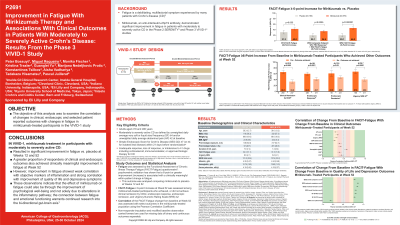Monday Poster Session
Category: IBD
P2691 - Improvement in Fatigue With Mirikizumab Therapy and Associations With Clinical Outcomes in Patients With Moderately to Severely Active Crohn’s Disease: Results From the PHASE 3 VIVID-1 Study
Monday, October 28, 2024
10:30 AM - 4:00 PM ET
Location: Exhibit Hall E

Has Audio

Miguel Regueiro, MD
Cleveland Clinic
Cleveland, OH
Presenting Author(s)
Peter Bossuyt, 1, Miguel D Regueiro, MD2, Monika Fischer, MD, MS3, Kristina Traxler, 4, Guanglei Yu, 4, Marijana Protic, 4, Konstantinos Tsilkos, 4, Aisha Vadhariya, 4, Tadakazu Hisamatsu, MD, PhD5, Pascal Juillerat, 6
1Imelda GI Clinical Research Center, Imelda General Hospital, Bonheiden, Antwerpen, Belgium; 2Cleveland Clinic, Cleveland, OH; 3Indiana University, Indianapolis, IN; 4Eli Lilly and Company, Indianapolis, IN; 5Kyorin University School of Medicine, Tokyo, Tokyo, Japan; 6Intesto Crohn's and Colitis Center, Bern and Fribourg, Bern, Bern, Switzerland
Introduction: Fatigue is a debilitating, multifactorial symptom experienced by many patients with Crohn’s disease (CD). Mirikizumab (MIRI), an anti-interleukin-23p19 antibody, demonstrated significant improvement in fatigue in patients with moderately to severely active CD in the Phase 2 AMAG and Phase 3 VIVID-1 studies.
Methods: This analysis examines the association of changes in clinical, endoscopic (endo) and selected patient-reported outcomes with changes in fatigue in MIRI-treated patients in the VIVID-1 study. Co primary and gated secondary outcomes, including comparisons with ustekinumab, have been presented elsewhere. Adult patients (N=1065) with moderately to severely active CD were randomized 6:3:2 to MIRI, ustekinumab or placebo. MIRI was given every 4 weeks (W) as 900 mg intravenous at W0, W4, and W8, then 300 mg subcutaneous from W12 to W52. Fatigue was assessed via the validated Functional Assessment of Chronic Illness Therapy-Fatigue (FACIT-F) questionnaire (scale from 0-52, higher scores indicating less fatigue and at least 6-point increase identified as a clinically meaningful within-patient change). Achievement of ≥6-point increase in FACIT-F at W52 was reported among those with and without clinical remission by Crohn’s Disease Activity Index (CDAI), endo response, endo remission, and Urgency Numeric Rating Scale (NRS) ≤2 at W52.For stool frequency (SF), abdominal pain (AP), fecal calprotectin (FCP), and C-reactive protein (CRP), the association of the change from baseline (CFB) at W52 vs. the CFB in FACIT-F at W52 was assessed by the Pearson correlation coefficient.
Results: At W52, 50.9% (268/527) of MIRI-treated patients achieved FACIT-F ≥6-point increase from baseline. Greater proportions of patients who achieved clinical and endo outcomes had ≥6-point increase in FACIT-F (p< 0.05) vs. those who did not achieve the outcome (Table). There was weak/moderate correlation between CFB at W52 in AP, SF and log-transformed FCP and CRP, and the CFB in FACIT-F at W52 (Table).
Discussion: In patients with moderately to severely active CD treated with MIRI, improvements in clinical, endoscopic, and selected patient-reported outcomes were associated with clinically meaningful improvements in fatigue at W52.
Note: The table for this abstract can be viewed in the ePoster Gallery section of the ACG 2024 ePoster Site or in The American Journal of Gastroenterology's abstract supplement issue, both of which will be available starting October 27, 2024.
Disclosures:
Peter Bossuyt, 1, Miguel D Regueiro, MD2, Monika Fischer, MD, MS3, Kristina Traxler, 4, Guanglei Yu, 4, Marijana Protic, 4, Konstantinos Tsilkos, 4, Aisha Vadhariya, 4, Tadakazu Hisamatsu, MD, PhD5, Pascal Juillerat, 6. P2691 - Improvement in Fatigue With Mirikizumab Therapy and Associations With Clinical Outcomes in Patients With Moderately to Severely Active Crohn’s Disease: Results From the PHASE 3 VIVID-1 Study, ACG 2024 Annual Scientific Meeting Abstracts. Philadelphia, PA: American College of Gastroenterology.
1Imelda GI Clinical Research Center, Imelda General Hospital, Bonheiden, Antwerpen, Belgium; 2Cleveland Clinic, Cleveland, OH; 3Indiana University, Indianapolis, IN; 4Eli Lilly and Company, Indianapolis, IN; 5Kyorin University School of Medicine, Tokyo, Tokyo, Japan; 6Intesto Crohn's and Colitis Center, Bern and Fribourg, Bern, Bern, Switzerland
Introduction: Fatigue is a debilitating, multifactorial symptom experienced by many patients with Crohn’s disease (CD). Mirikizumab (MIRI), an anti-interleukin-23p19 antibody, demonstrated significant improvement in fatigue in patients with moderately to severely active CD in the Phase 2 AMAG and Phase 3 VIVID-1 studies.
Methods: This analysis examines the association of changes in clinical, endoscopic (endo) and selected patient-reported outcomes with changes in fatigue in MIRI-treated patients in the VIVID-1 study. Co primary and gated secondary outcomes, including comparisons with ustekinumab, have been presented elsewhere. Adult patients (N=1065) with moderately to severely active CD were randomized 6:3:2 to MIRI, ustekinumab or placebo. MIRI was given every 4 weeks (W) as 900 mg intravenous at W0, W4, and W8, then 300 mg subcutaneous from W12 to W52. Fatigue was assessed via the validated Functional Assessment of Chronic Illness Therapy-Fatigue (FACIT-F) questionnaire (scale from 0-52, higher scores indicating less fatigue and at least 6-point increase identified as a clinically meaningful within-patient change). Achievement of ≥6-point increase in FACIT-F at W52 was reported among those with and without clinical remission by Crohn’s Disease Activity Index (CDAI), endo response, endo remission, and Urgency Numeric Rating Scale (NRS) ≤2 at W52.For stool frequency (SF), abdominal pain (AP), fecal calprotectin (FCP), and C-reactive protein (CRP), the association of the change from baseline (CFB) at W52 vs. the CFB in FACIT-F at W52 was assessed by the Pearson correlation coefficient.
Results: At W52, 50.9% (268/527) of MIRI-treated patients achieved FACIT-F ≥6-point increase from baseline. Greater proportions of patients who achieved clinical and endo outcomes had ≥6-point increase in FACIT-F (p< 0.05) vs. those who did not achieve the outcome (Table). There was weak/moderate correlation between CFB at W52 in AP, SF and log-transformed FCP and CRP, and the CFB in FACIT-F at W52 (Table).
Discussion: In patients with moderately to severely active CD treated with MIRI, improvements in clinical, endoscopic, and selected patient-reported outcomes were associated with clinically meaningful improvements in fatigue at W52.
Note: The table for this abstract can be viewed in the ePoster Gallery section of the ACG 2024 ePoster Site or in The American Journal of Gastroenterology's abstract supplement issue, both of which will be available starting October 27, 2024.
Disclosures:
Peter Bossuyt: AbbVie – Advisory Committee/Board Member, Grant/Research Support, Lecture fees. Amgen – Grant/Research Support. Arena pharmaceuticals – Advisory Committee/Board Member. Benelux – Advisory Committee/Board Member. Bristol Myers Squibb – Advisory Committee/Board Member, Lecture fees. CAG – Lecture fees. Celltrion – Advisory Committee/Board Member, Lecture fees. CiRC Biosciences – Advisory Committee/Board Member. Dr. Falk Pharma – Advisory Committee/Board Member. Eli Lilly and Company – Advisory Committee/Board Member, Grant/Research Support, Lecture fees. EPGS – Lecture fees. Galapagos NV – Advisory Committee/Board Member, Lecture fees. Globalport – Lecture fees. Hospira – Advisory Committee/Board Member. Janssen – Advisory Committee/Board Member, Grant/Research Support, Lecture fees. Materia Prima – Lecture fees. Merck – Advisory Committee/Board Member. Mundipharma – Advisory Committee/Board Member, Grant/Research Support. Mylan – Grant/Research Support. Pentax – Advisory Committee/Board Member, Lecture fees. Pfizer – Grant/Research Support, Advisory board fees. PSI CRO – Advisory Committee/Board Member. Roche – Advisory Committee/Board Member. Sandoz – Advisory Committee/Board Member. Scope – Lecture fees. Takeda – Advisory Committee/Board Member, Lecture fees. Tetrameros – Advisory Committee/Board Member. Viatris – Grant/Research Support.
Miguel D Regueiro: AbbVie – Advisory Committee/Board Member, Consultant, Speakers Bureau.
Monika Fischer: AbbVie – Consultant. Bristol Myers Squibb – Consultant. Eli Lilly and Company – Consultant. Ferring Pharmaceuticals – Consultant. Janssen – Consultant. Pfizer – Consultant. Rebiotix – Consultant. Scioto Biosciences – Consultant. Seres Therapeutics – Consultant.
Kristina Traxler: Eli Lilly and Company – Employee, Stock Options.
Guanglei Yu: Eli Lilly and Company – Employee, Stock Options.
Marijana Protic: Eli Lilly and Company – Employee, Stock Options.
Konstantinos Tsilkos: Eli Lilly and Company – Employee, Stock Options.
Aisha Vadhariya: Eli Lilly and Company – Employee, Stock Options.
Tadakazu Hisamatsu: AbbVie – Grant/Research Support, lecture fees. Bristol Myers Squibb – Consultant. Daiichi-Sankyo – Grant/Research Support. EA Pharma – Consultant, Grant/Research Support, lecture fees. Gilead Sciences – Consultant. Janssen – Consultant. JIMRO – Grant/Research Support. Mitsubishi Tanabe Pharma Corporation – Grant/Research Support, lecture fees. Mochida Pharmaceutical – Grant/Research Support. Nippon Kayaku – Grant/Research Support. Pfizer – Grant/Research Support. Takeda Pharmaceutical – Grant/Research Support, lecture fees.
Pascal Juillerat: AbbVie – Advisory Committee/Board Member, Consultant, Speakers Bureau. Amgen – Advisory Committee/Board Member, Consultant, Speakers Bureau. Arena Pharmaceuticals – Advisory Committee/Board Member, Consultant, Speakers Bureau. Bristol Myers Squibb – Advisory Committee/Board Member, Consultant, Speakers Bureau. Eli Lilly and Company – Advisory Committee/Board Member, Consultant, Speakers Bureau. Ferring Pharmaceuticals – Advisory Committee/Board Member, Consultant, Speakers Bureau. Gilead Sciences – Advisory Committee/Board Member, Consultant, Speakers Bureau. Janssen – Advisory Committee/Board Member, Consultant, Speakers Bureau. Merck Sharp & Dohme – Advisory Committee/Board Member, Consultant, Speakers Bureau. Pfizer – Advisory Committee/Board Member, Consultant, Speakers Bureau. Pierre Fabre – Advisory Committee/Board Member, Consultant, Speakers Bureau. Roche – Advisory Committee/Board Member, Consultant, Speakers Bureau. Sandoz – Advisory Committee/Board Member, Consultant, Speakers Bureau. Takeda – Advisory Committee/Board Member, Consultant, Speakers Bureau. Tillots Pharma AG – Advisory Committee/Board Member, Consultant, Speakers Bureau. UCB Pharma – Advisory Committee/Board Member, Consultant, Speakers Bureau. Vifor Pharma – Grant/Research Support.
Peter Bossuyt, 1, Miguel D Regueiro, MD2, Monika Fischer, MD, MS3, Kristina Traxler, 4, Guanglei Yu, 4, Marijana Protic, 4, Konstantinos Tsilkos, 4, Aisha Vadhariya, 4, Tadakazu Hisamatsu, MD, PhD5, Pascal Juillerat, 6. P2691 - Improvement in Fatigue With Mirikizumab Therapy and Associations With Clinical Outcomes in Patients With Moderately to Severely Active Crohn’s Disease: Results From the PHASE 3 VIVID-1 Study, ACG 2024 Annual Scientific Meeting Abstracts. Philadelphia, PA: American College of Gastroenterology.
